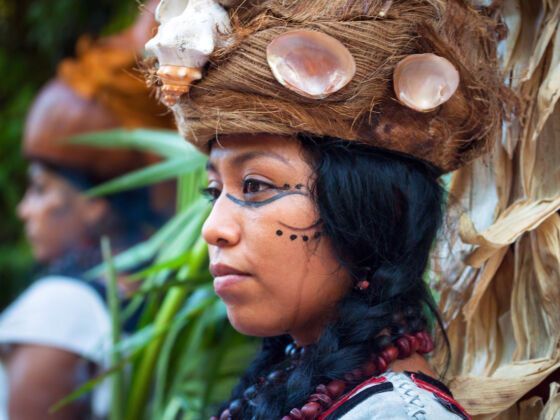[Editor’s note: Megan Wood is the first writer-in-residence to participate in the Road Warrior program, a partnership between MatadorU and the Belize Tourism Board. Megan is spending the spring in Belize, documenting traditions of the country’s diverse cultural groups. Each week, she reports on her experiences for Matador, her personal blog, and for other outlets.]


CRISTINA, a Kekchi Maya woman who lives near Lubaantun in Belize, took me to visit the ancient Maya site located a few miles from her home where she sells weaving and her husband farms cacao. We walked up the hill to the site during the hottest part of the day; me, sweating in my shorts, and Cristina, wearing a homemade conservative dress, barely noticing the heat.
As we wandered around the once great military site — now mostly abandoned piles of limestone — she pointed out the palm leaves her family uses to make roofs on houses. Two children followed us eating unripe mangoes they found on the ground and fighting with each other in Kekchi.
Cristina knew a lot about the rainforest plants and their uses, but when I asked her what she thought happened to her ancestors she shrugged her shoulders and said, “I don’t know. They just died and left all these rocks. Then the British came and took the treasure.”
The ancient Maya had writing skills, planned cities, and built pyramids. No one is really sure what caused the fall of the Maya people, though it was probably a combination of disease, famine, and warfare. Belize was once the heart of the Maya Empire, with two million living, farming, and, yes, sacrificing virgins since 2000 BC.
Today, the Maya population in Belize is a tiny fraction of what it once was, but remaining Maya hold many of the traditions their ancestors did: farming cacao, grinding corn for tortillas, playing the marimba, and annually dancing the Deer Dance.
While Cristina and I continued to walk around the fallen rocks of the looted ruins I decided I would start asking Belizeans with Maya heritage to tell me more about 2012 and what they really think will be the fate of the world.
The Maya Calendar
The Maya had a complex way of keeping track of time that was based on three separate calendars. The calendar that many people think predicts the end of the world is called “The Long Count” and it keeps track of the beginning of the universe until the end of time. On December 21, 2012, the calendar ends.
December 21, 2012, is an interesting astrological date
December 21st is the winter solstice, which means the sun will reach its northernmost extreme. The Maya had accurate knowledge of astronomical events; they used monuments, buildings, and wooden implements to make fixed lines of sight for observing celestial bodies, and recorded the passage of the sun and moon. They predicted lunar eclipses and correctly computed the length of a year as 365.2420 days. Despite their stone technology, the Maya were incredibly accurate.
Age of Enlightenment
Some current Maya, like Cristina’s family, think that 2012 will usher in a new age of spirituality for all of mankind. That the cosmos will somehow reveal to us a new way to live that promotes the environment, respect for humanity, and the end of war and hate. A glorious time of peace and understanding, not a fiery Armageddon.
Paul, a Mopan Maya, and shuttle driver in San Ignacio, told me he thinks that ancient Maya had access to 95% of their brain cells, an ability that was lost over time. His theory is that in 2012, humans will once again regain access to full brain capacity.
Big New Year’s party
Jake, a guide with Yucatec Maya heritage and with a master’s degree in archaeology, showed me around the Xunantunich Ruins near the border of Guatemala. After he explained a penis-piercing ritual to me with enough detail to make me dizzy, I asked him his theory of 2012.
He told me, “December 21, 2012, is just a change in the Maya calendar year. For us, it will be the end of one calendar cycle, and the beginning of a new one.”
The ancient Maya didn’t believe in endings. Their concept of time was circular, not linear. So why would 2012 be any different? Just like Western society celebrates the new year, every year on December 31st, the Maya will celebrate a new cycle on December 21.
But who knows?
The Maya believed that the world had been created and destroyed several times. Humans had been created and destroyed three times. In the first creation they were made from clay, in the second, from sticks, and in the third, from corn. The last creation dated 3114 BC and is expected to end in the year 2012. And next?